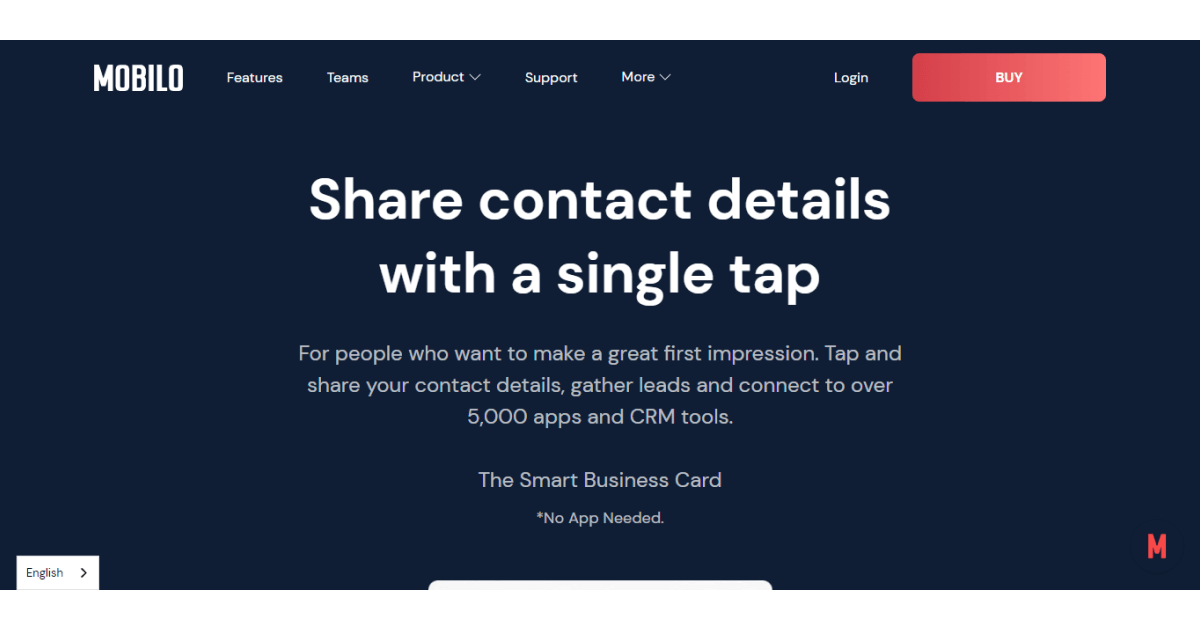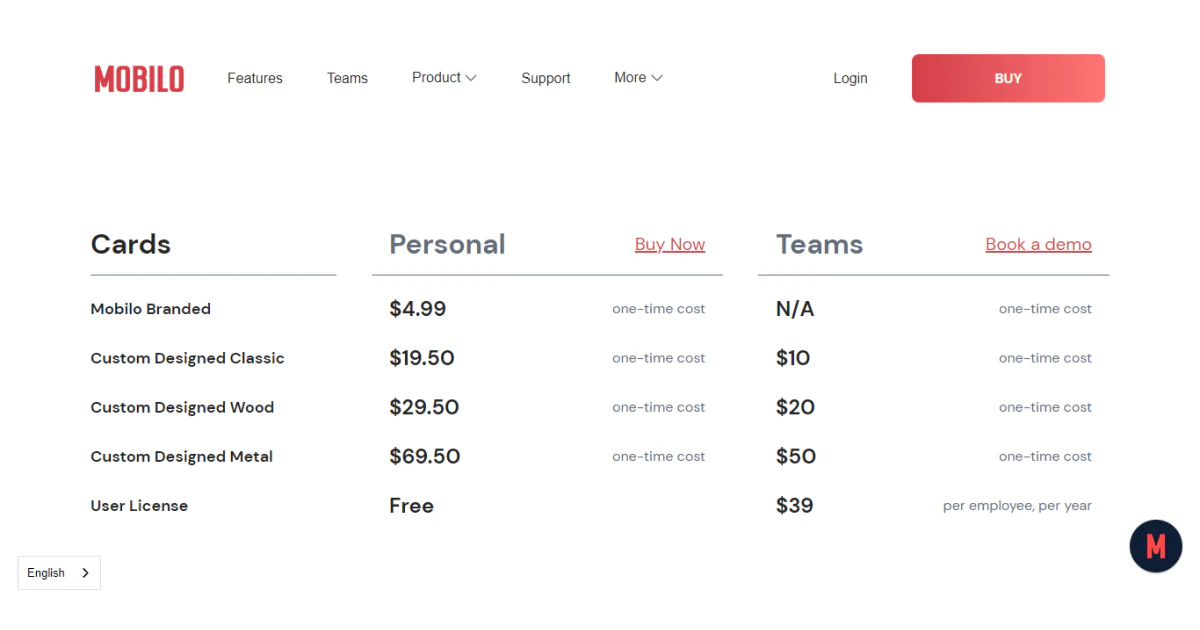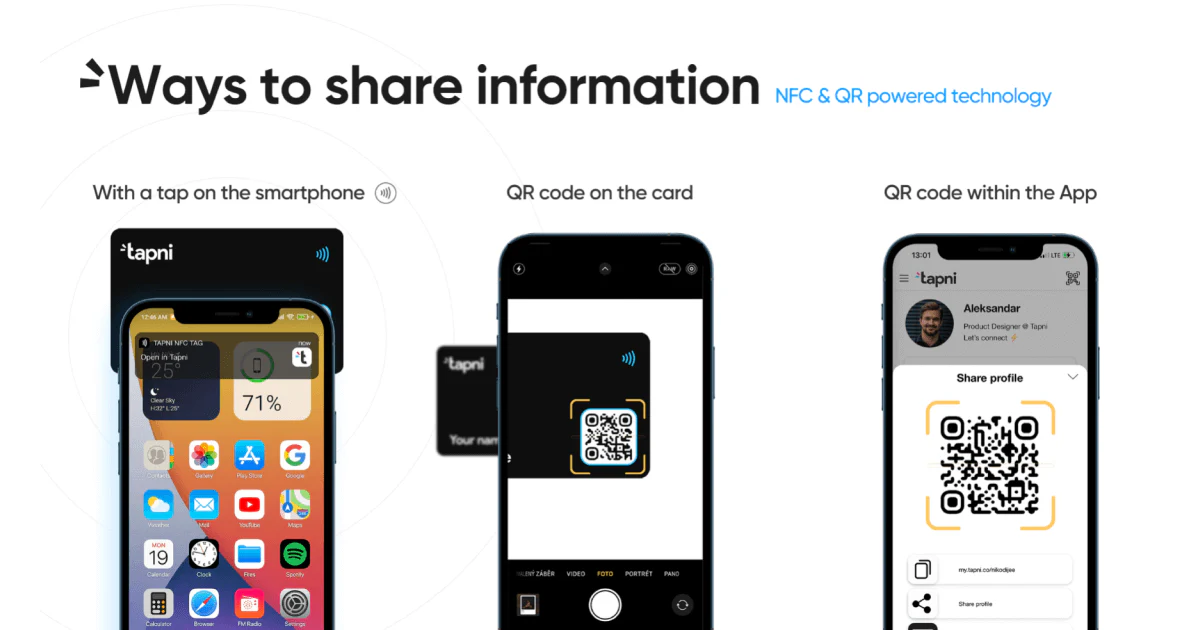Browse our comprehensive product guides and documentation


Gone are the days when you had to carry clunky and bulky physical business cards to hand out at networking events.
Now, we have digital business cards that you can share with potential partners or employers with just a tap.
Furthermore, the expansion of mobile phones also boosted the use of digital business cards, leading to a great number of digital business card providers.
Actually, the digital business card market is expected to continue growing at an 11.2% CAGR by 2027.
But sometimes, too many options make it harder to choose the right one for your business.
What design should you use, how safe are the cards in question, is the setup process complex, etc?
So to help you out, we’ll take a look at two of the leading digital business card providers: Mobilo and V1Ce, and compare their features to help you decide which one is best for your needs.
Read on to find out about their features, pros, and cons so that you can make an informed decision.
Let's start with our Mobilo vs. V1CE comparison!

Mobilo creates digital business cards, as well as smart buttons and key fobs.
It focuses on team and business and provides tools for measuring, monitoring, and managing your teams.

V1CE also covers a greater scope than just creating digital business cards, so you can also create phone cases, RFID wallets, and accessory packs.
Depending on the pack you choose, you can order key rings, wristbands, cardholders, or lanyards.
With such stiff competition among digital business card providers, it’s not surprising that each provider tries to step up the game and offer what others might lack.
Thus, in the digital business card world, the difference in features can sometimes be striking.
Let’s see how similar or different Mobilo and V1CE are.
Most digital business card apps are usually limited considering the choice of colors and customization, but not Mobilo because it offers more colors and pattern options.

Furthermore, you print your design on regular or business card paper in either color or monochrome.
You can choose any of the three types: Plastic, Wood, and Metal.
Metal cards are available in Black, Silver, and Gold and have a brushed finish, whereas plastic cards can have a matte or glossy finish.
Wooden cards are eco-friendly, available in Berch and Sapele, and have a polished finish.
What makes Mobilo different is how it gave a makeover to the QR code and combined it with your logo.
Thus you can center your logo on the square-shaped or round QR code, but you can also place it as the background of the QR code.

In addition, you can incorporate your brand colors, providing that the contrast is over 30% between the QR Code color and the background.
So apart from being versatile in terms of customization, Mobilo also offers great features for teams and businesses beyond digital business cards.
Therefore, you can measure, monitor, and manage your teams and collect, compare, and report on individual or team data.
Furthermore, you can:
🔥 fill out, sync, update, or lock each team member’s profile,
🔥 organize members by group, department, or location,
🔥 calculate ROI at events,
🔥 apply custom and consistent branding across all channels,
🔥 connect and send leads to your CRM and marketing automation tools,
🔥 benefit from over 3000 integrations,
🔥 and much more.
In a nutshell, Mobilo is a robust app, especially for businesses and teams that will benefit from measuring and tracking tools.
Regarding digital business cards, V1CE offers three options: metal, bamboo, or plastic.
Each card type has a QR code at the back, which is practical for users with devices not compatible with NFC.

The metal business card collection is trendy due to its sleek, sophisticated design, and expensive look.
You can choose from black, blue, green, white, silver, and gold options.
Since V1CE nurtures a more classical and elegant look of their digital business cards, the color range isn’t as wide as in some other providers.
However, if you really want to add a dash of luxury, a 24K gold option is also available, which embeds the NFC chip in a thick 24K gold sheet.
One thing V1Ce does differently from its competitors is not incorporating its branding anywhere on the card.
Depending on your subscription model, the access to features differs. V1Ce hit it out of the park when it comes to the number of features you can use in the free option.
Regarding Pro features, V1CE offers Accordion, Photo gallery, Lead Forms, and Video Embedding options.
On the other hand, unlike Mobilo, it doesn’t offer tracking and measuring tools for teams and businesses.
Both apps are great and use top-notch materials to create their products. In addition, neither requires software.
However, a winner for me in this category would be Mobilo due to its wider customization options and useful tools and metrics for teams and businesses.
No matter how great an app or a product might be, it’s futile if you have to jump through hoops to use it.
Customers love products that are hassle-free and don’t have a steep learning curve.
Creating your digital business card is smooth and takes 4 steps:
Once you’ve provided all the info, you can set up your profile and do updates in real-time.
You can easily add new contacts and keep track of their contact information.
Each Mobilo card has three modes of usage.

Every mode has a distinctive action assigned to it, and you can switch between the modes with a card tap.
Besides the basic info and your profile picture, you can put links to your social media, messaging, and payments.
Moreover, you can use a Calendar option and add notes and reminders for activities or tasks you don’t want to forget or miss.
When we speak of ease of use, there is a subcategory that definitely contributes to how easy or not it is to use digital business cards: Sharing Options.
The three modes you can activate are also ways to share and exchange contact info.
So, you can share your info by tapping, sharing URLs, or scanning the QR code.
And now, let’s see how intuitive V1Ce is.
The process of creating a digital business card is similar, if not the same, to most digital card providers:
After you’ve completed the above steps, you’ll end up on the landing page, again without V1CE branding.
Furthermore, with V1CE, you can store multiple profiles, which is excellent for multiple businesses.
Additionally, you can reorder the actions and customize the layout of your actions.

However, even though V1Ce provides many features, many users find the setup process not very intuitive, with too many things going on and too many things they need to tap.
Thus, the setup process can be overwhelming.
V1CE has two sharing options:
In either case, the recipient doesn’t need to install the app or have it to see your info.
Overall, both Mobilo and V1CE are self-explanatory, but if I had to choose, Mobilo would score slightly higher due to the more straightforward setup process.
The next aspect we’ll cover is crucial yet delicate: Security.
With the expansion of digital business cards, making sure that the website or app you use to create and store your card is one of the top priorities.
Check if the providers have strong password protection and encryption, and if possible, try using a two-factor authentication method to protect your account further.
Mobilo is SOC 2 compliant, type 1, meaning it’s been through an independent audit, and met the requirements of the SOC 2 standard.
And what is the SOC 2 standard?
The SOC 2 standard is a set of guidelines that businesses can use to ensure the security and confidentiality of their data.
It has five key principles:
🔥 security
🔥 availability
🔥 processing integrity
🔥 confidentiality, and
🔥 privacy.
To comply with SOC 2, businesses must have controls and procedures addressing all five principles.
By adhering to SOC 2 standards, businesses can assure their customers that their data is safe and secure.
This is the highest level of assurance that an organization can achieve.

Thus, in terms of security, things look really promising for Mobilo, right?
Let’s see if V1CE’s security is equally impressive.
V1Ce uses AWS architecture which stands for Amazon Web Services - cloud services that handle high web traffic (see, e.g., a website traffic checker) and the vast amounts of data generated daily on apps or websites.
Furthermore, some of V1CE’s products, such as RFID-blocking wallets, offer protection against “electronic pickpocketing”, called RFID skimming.
The security category is a very sensitive one, so perhaps the best thing to do is to call it a draw.
Although Mobilo provides more security theoretically, there are always risks with any new-age technology.
However, digital business cards from trustworthy and reliable providers should be safe because they share rather than extract information.
Furthermore, your financial information isn’t stored on them.
The last category we’ll cover before moving to pros and cons is the inevitable pricing.
Mobilo digital business cards' price ranges from $4,99 to $69,50 for individual use.
The prices for the companies vary depending on the size of your team and add-ons, but most likely, it won’t be under at least $100.

V1CE card prices range from $50 to $370, whereas the accessory packs range from $38 to $56.

To summarize the Mobilo vs. V1CE battle, let’s go through their main pros and cons.
Pros and cons are a great way to highlight the advantages and shortcomings of a product so that you can make a more informed decision.
✔️ It has a great variety of prints and designs.
✔️ It provides excellent tools for businesses and teams, such as CRM and tracking tools.
✔️ It is SOC 2 compliant.
✔️ It doesn’t require software installation.
⛔ It is necessary to have a year's license to access all the advanced features.
⛔ It doesn’t enable switching profiles.
⛔ It doesn’t have video embedding possibilities.
⛔ It can get pricey for teams.
✔️ It doesn’t include its branding on the cards.
✔️ It doesn’t require an app to work.
✔️ It offers multiple profiles.
⛔ It is pricey.
⛔ Its setup process can be overwhelming.
⛔ Bad interface design of an app.
⛔ Some users are not satisfied with the support.
All in all, Mobilo and V1ce are two great digital business card services offering different features for users.
Mobilo might be a better option if you’re looking for a fully-fledged service, whereas V1CE might be a good choice if you just want to quickly design a few cards with basic customizations.
In either case, both companies have something to offer, and ultimately, it all comes down to your needs.
Therefore, we hope our detailed look at both tools has provided a valuable and practical guideline to consider before making any decisions.
In the meantime, let’s show you an alternative that combines the coolest features of Mobilo and V1CE, but at a more affordable price.
Say hello to Tapni!

Tapni is a robust tool that creates digital business cards, keychains, stickers, and wristbands.

Furthermore, Tapni is one of the rare digital business card providers that offer high customization options and a choice of colors.
Therefore, you can choose from multiple templates and designs.

Furthermore, all business cards can have a glossy or matte finish depending on your preferences.
And if you care about the environment, then Tapni Bamboo Card is the perfect choice for you. It comes in natural and walnut colors.

Did you know that Tapni plants a tree for each purchased product?
Not only Tapni provides greater customization and color options, but Tapni also provides powerful features for teams and businesses.
So, with Tapni, you can manage teams, collect leads and automate workflow.
Or, in more detail, you can:
🔥 Easily create new cards for team members by synchronizing with your Azure, Google, or Slack Employee Directory.
🔥 Automate lead generation by importing contacts directly to your CRM system thanks to integrations with Salesforce, Hubspot, Pipedrive, Zapier, etc.
🔥 Export your connections to CSV.
🔥 Better understand networking activities due to our actionable analytics that gives you a better insight into the performance of your team and ROI measurements at events.
Furthermore, Tapni’s setup process is smooth and easy, making Tapni extremely intuitive.
And speaking of ease of use, the area where Tapni really shines is its multiple sharing options.
You can share and exchange contact info in three main ways:
However, you can also send your digital business card in the following ways:
And thanks to our users, we know which Tapni features or services they love the most:
🔥 a powerful dashboard with tools for teams and businesses
🔥 ease of use
🔥 multiple sharing options, and
🔥 high customization.
We’d love to know your thoughts.
So, join our growing fan base and create your very own Tapni digital business card to boost your networking effortlessly and with style.
The number of digital business card providers is growing by day, but the other current top players are Tapni, Linq, Dot, Popl, etc.
For a more detailed comparison, jump to one of our blogs about Linq Alternatives, 5 Best Digital Card Solutions, or Linq vs. Dot Comparison.
The biggest difference is that a digital business card can be highly customizable and can include various multimedia elements, such as images, videos, and interactive content. On the other hand, a virtual card can be customized but is usually restricted to text-based information.
Considering that your digital business card is your professional mirror, you shouldn’t include information such as: unprofessional images or videos, irrelevant links and URLs, unprofessional social media profiles, and redundant information.
For more ideas on what to include on your card, check our blog on the 6 Best Digital Business Card Ideas To Inspire You.